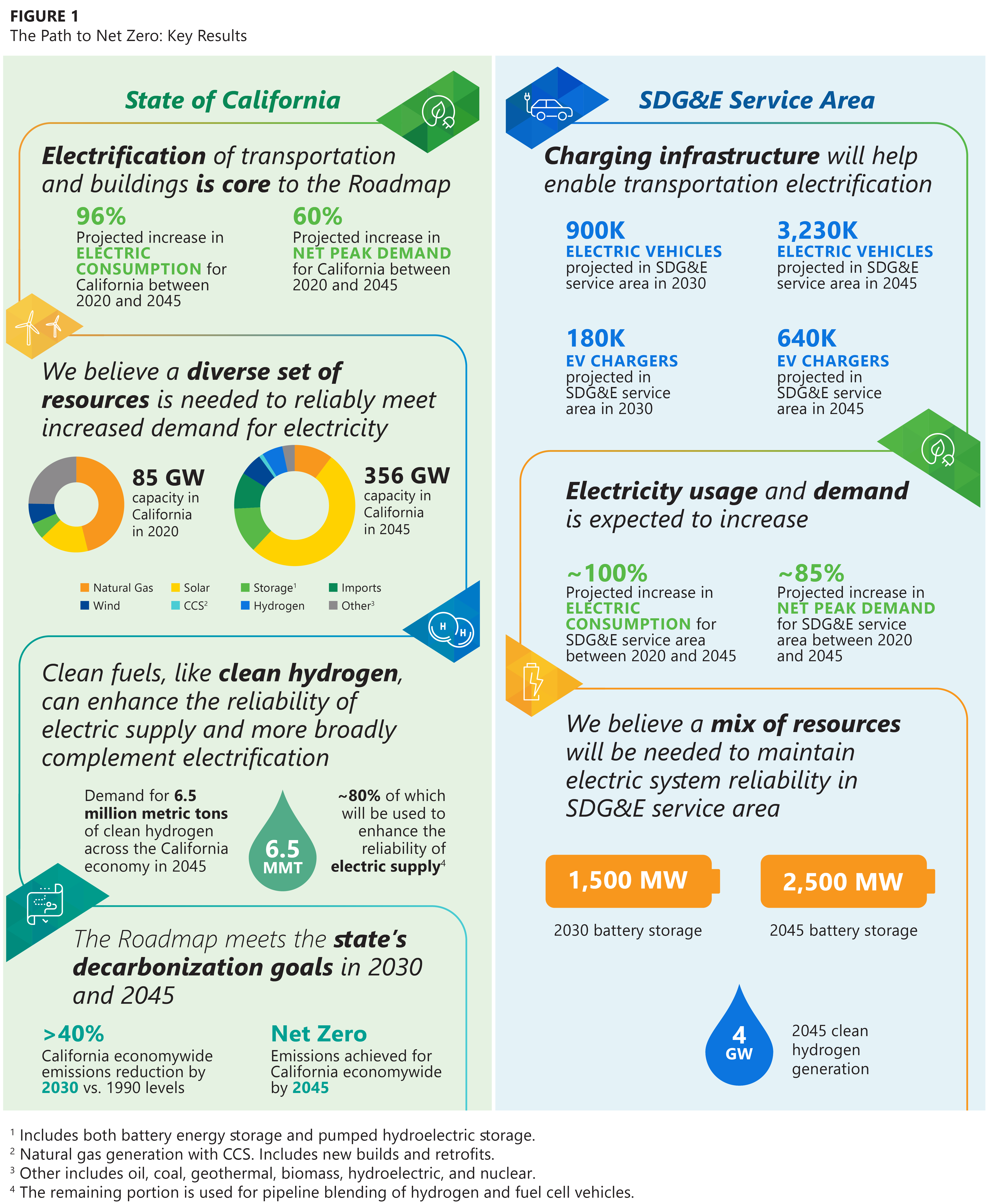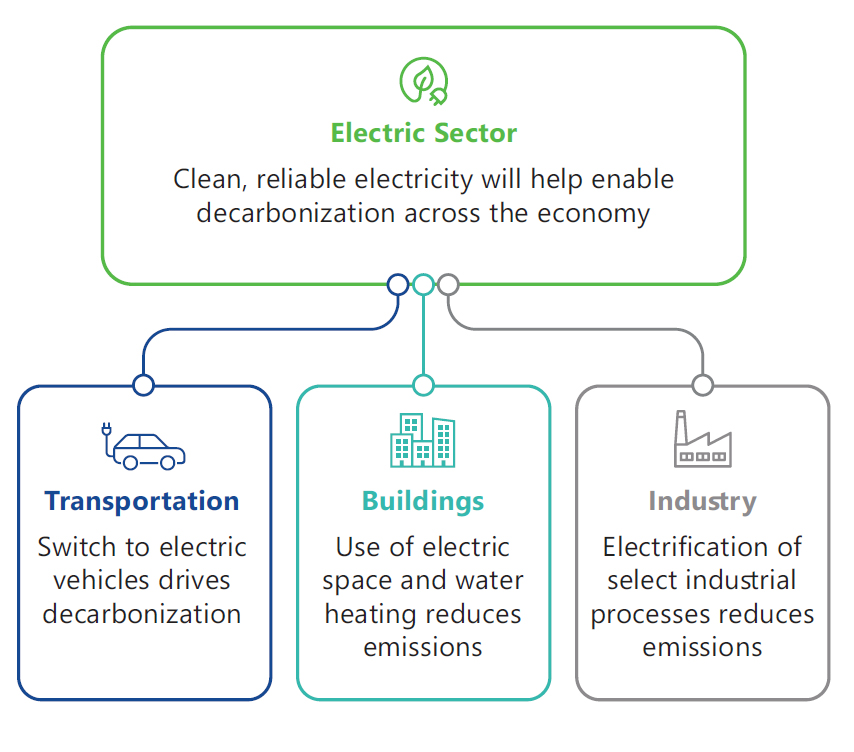The Path to Net Zero: A Decarbonization Roadmap for California
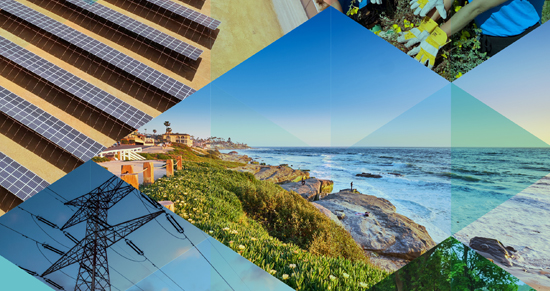
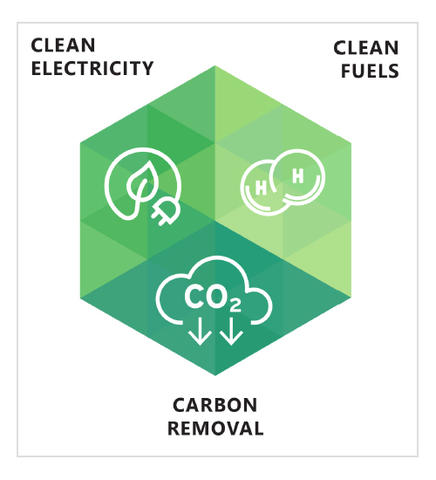
California is targeting a just and equitable energy transition to achieve carbon neutrality by 2045. That means removing as much carbon from the atmosphere as California produces. In the San Diego and southern Orange County region, SDG&E and many local cities also embrace carbon neutrality as their goal.
To stimulate community engagement and economywide collaboration to achieve our shared climate goals, SDG&E has published its vision on how to decarbonize the economy while also prioritizing grid reliability, affordability and equity. The Path to Net Zero: A Decarbonization Roadmap for California lays out specific recommendations for the state to achieve carbon neutrality by 2045.
This Roadmap is the first publicly available analysis to use the utility industry reliability standard and industry-specific planning tools to evaluate electric reliability in modeling how to decarbonize California through 2045. Conducted with technical support from the Boston Consulting Group, Black & Veatch and UC San Diego Professor David Victor, the study concluded that a diversified decarbonization approach is necessary: a combination of clean electricity, clean fuels (such as renewable natural gas and clean hydrogen), and carbon removal.
We invite you to check out the study and collaborate with us to build a more decarbonized, equitable and affordable future for all.
Ensuring Reliable Energy Service
Clean, safe and reliable electricity is foundational to California’s future and economic prosperity. To meet its goal of becoming carbon neutral by 2045, California will need to decarbonize at 4.5 times the pace over the past decade and grow its electric system capacity to approximately four times the capacity that existed in 2020. A dramatic expansion in energy generation is needed to support the electrification of transportation and buildings, which currently account for about 41% and 14% of California’s GHG emissions, respectively.*
In the future, electricity must be both clean and reliable, even as energy consumption increases dramatically.
The Path to Net Zero: A Decarbonization Roadmap for California is the first study to apply the utility industry standard for reliability to model decarbonization. The standard, known as the one-in-ten loss of load expectation (LOLE), considers an electric system to be highly reliable if the probability of a power outage from energy demand exceeding firm electric supply is less than one day every 10 years.
As electricity consumption increases, additional electric infrastructure will be necessary for California to support decarbonization and reliability. The Roadmap forecasts that California will need to rapidly grow its mix of both in-state and imported renewable power, enabling the geographic diversification of renewable power and minimizing the impact of weather events, such as extreme heat or cold. Additionally, the statewide grid will need to integrate significantly more energy storage to help balance demand with supply, as well as generation from 100% clean hydrogen combustion.
*California Air Resources Board (CARB) 2000-2019 GHG Inventory (2021 edition, by economic sector).
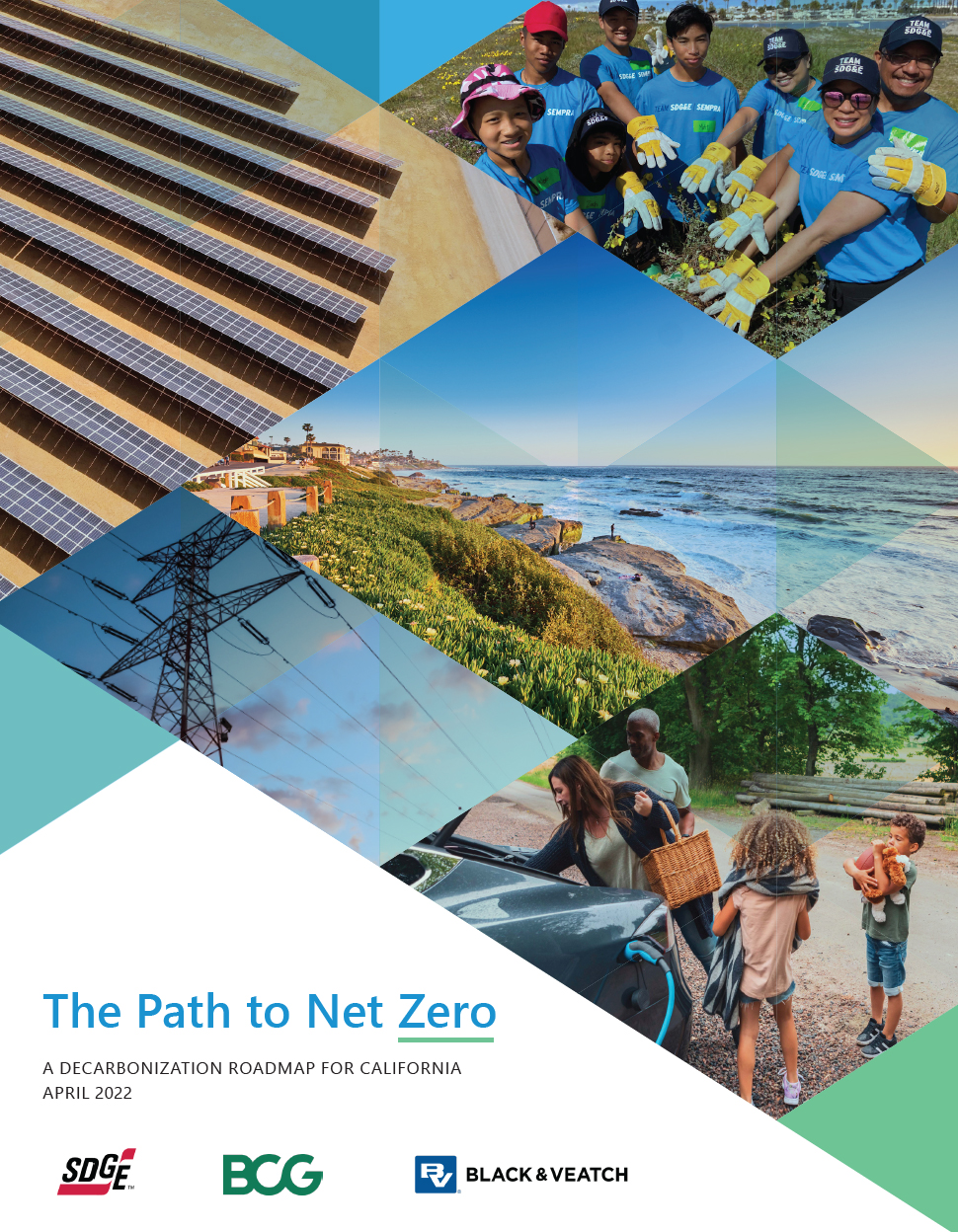

Addressing Energy Affordability
and Climate Equity
Given record inflation, higher energy prices and the cost of living in California, SDG&E is acutely aware of the financial challenges facing our customers. The important work of decarbonization must be balanced with affordability. The investments required to bring more clean energy innovations online must be carefully planned to ensure that the state’s businesses, residents and organizations can bear the costs and realize the benefits equitably.
Affordability and equity are intertwined.
To better understand future impacts of decarbonization on affordability and equity, The Path to Net Zero: A Decarbonization Roadmap for California estimates illustrative changes to residential customers’ total annual energy expenses (ongoing costs only), including projected electric and gas utility bills, as well as transportation costs, over time. According to the Roadmap, customers who are able to electrify and actually do so could have similar ongoing energy costs in 2045 compared to today, excluding future inflation effects. However, successful decarbonization should ensure that everyone is able to adopt decarbonization technologies and benefit from the clean energy transition.
Advancing a Clean Energy Future
While progress is continuing to be made, additional regulatory and policy support is necessary to meet California’s goal to be carbon neutral by 2045. The Path to Net Zero: A Decarbonization Roadmap for California makes the following recommendations on the regulatory and policy fronts:
- Maintain affordability and enhance equity by reforming gas and electric rates and exploring alternative funding and recovery mechanisms for public programs, supporting low-income households so they can benefit from the clean energy transition (for example, financial incentives to offset the upfront costs of buying an electric vehicle), and investing in training programs to redeploy affected workers.
- Prioritize electric system reliability by incorporating it into long-term state planning, implementing a regional transmission organization and adopting inclusive technology solutions.
- Incentivize innovation and adaptability by encouraging research and development and supporting pilot programs that help develop emerging technologies meet the required pace of decarbonization.
- Enable the deployment of decarbonization infrastructure by simplifying regulatory reviews and the process to use federal lands, as well as mobilizing capital to support new developments.

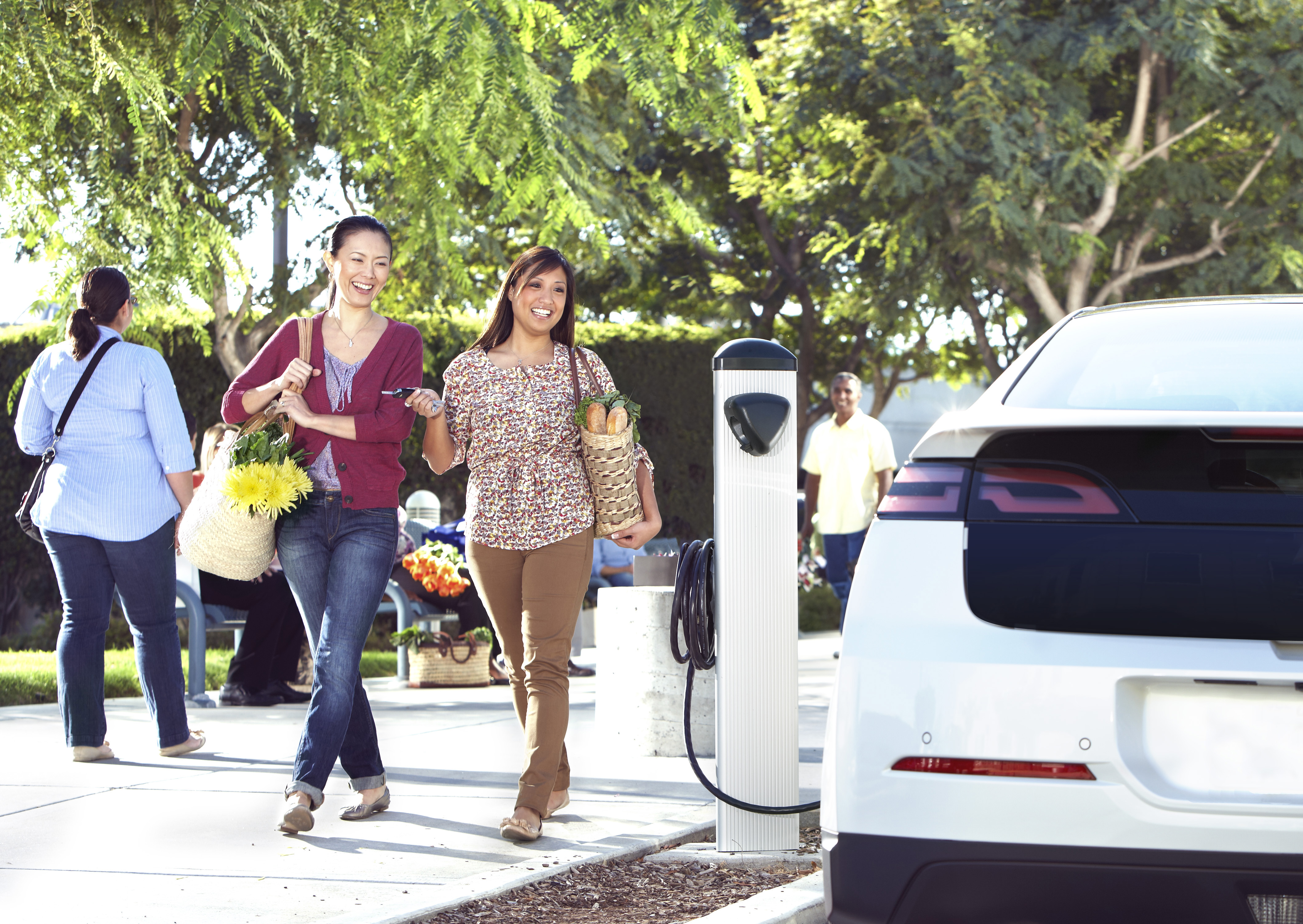
What SDG&E is Doing to Help
We are sharing the findings of our study, The Path to Net Zero: A Decarbonization Roadmap for California, widely with leaders in the public, private, nonprofit and academic sectors because we recognize building a net zero future cannot be done alone. SDG&E has been and will continue to work with a broad range of stakeholders to help decarbonize the regional and statewide economy.
In October 2020, we established a comprehensive sustainability strategy. In March 2021, we solidified our sustainability commitment by pledging to reach net zero greenhouse gas (GHG) emissions by 2045, in alignment with California’s climate goal. Our pledge involves reducing all three scopes of emissions, both those generated by SDG&E’s operations and our customers’ consumption of the energy delivered by us. Each year, SDG&E reports on our progress toward net zero. We will continue to make updates to the Roadmap and our sustainability strategy as technologies, customer adoption of innovations, policies and regulations evolve.
Learn more about SDG&E's sustainability strategy by visiting sdge.com/sustainability.
We want to hear from you!
We value the voices of the residents, organizations and businesses in our region. If you have comments or feedback regarding our goals, our strategy or even concerns you may have around decarbonization, please share your thoughts.
Additionally, if you want to be notified of updates on decarbonization, progress on our goals or other announcements, fill out the forms below to connect with us.
